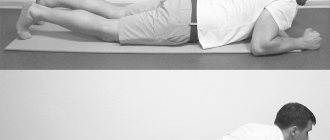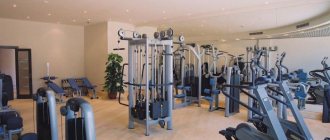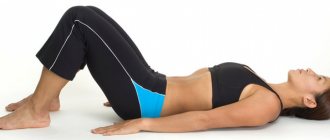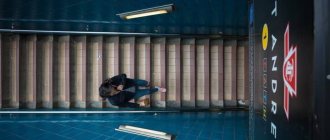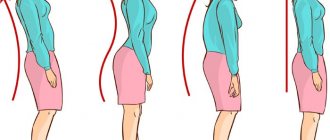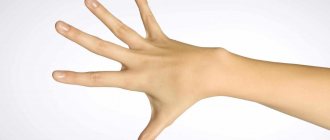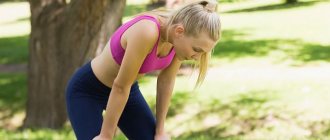Exercise "Cat"
Starting position – standing on all fours. The palms are located directly under the shoulders, the knees are under the hips. Don't throw your head up or forward.
Squeeze your shoulder blades as much as possible and arch your back. Stay in this position for several breaths.
Then round your back as much as possible, squeeze your buttocks, spread your shoulder blades and, as far as possible, stretch your back up. Stay in this position for several breaths.
Repeat the exercise several times.
What does this exercise do? Warm up the spine, massage the abdominal organs. The exercise is especially useful for women, as it tones the female reproductive system.
https://youtu.be/Y65loTp5JC0
Relieving tension from the spine! Back stretching exercises
The spine is the main rod on which our entire body rests. Even in ancient times, healers believed that the spinal column was the seat of human energy. And they were absolutely right. The spine, like a bone case, contains very important formations. This is the spinal cord - the most important part of the nervous system. Figuratively speaking, the spinal cord is a huge number of wires or cables through which nerve signals travel to different parts of our body.
The spine is a rather complex structure, consisting of various bones (vertebrae), cartilage (a shock-absorbing structure that helps the vertebrae interact with each other), ligaments and muscles (the structure that makes the spine move: bend, bend, twist).
Back exercises at home
The optimal performance of the spinal column can be disrupted by aging, disease, injury and wear of intervertebral cartilage caused by poor lifestyle choices.
Subscribe to our INSTAGRAM account!
Our back is under tension for almost a full day. When we walk or sit, drive to work or carry heavy objects in our hands, when we run or jump, all this time the intervertebral discs experience pressure that occurs due to the force of gravity. And even when we sleep, the spine cannot completely relax. This is due to incorrect body position or incorrect bed. Subsequently, the distance between the vertebrae decreases, while the load on the muscles increases, which leads to their redistribution. Painful impulses are sent to the muscles from the affected areas of the spine, the vertebrae compress the intervertebral discs, and the blood vessels and nerves are compressed. A person experiences pain in the spine, legs or arms, skin sensitivity is impaired, immobility of the spinal column may occur or restriction of movements in the limb corresponding to the affected segment of the spine may occur.
Now we see that it is vital for a person to relax his back, relieve tension from the spine and the muscles running along it. A set of exercises for stretching the back muscles and traction of the spinal column will help us with this . The exercises suggested below will help increase the distance between the vertebrae, lengthen the shortened muscle fiber, as a result of which blood circulation will improve and metabolic processes in the spine will be normalized. The restoration and growth of intervertebral discs, with constant training of the spinal column, will make the spine flexible, stretched and healthy. Exercises will also help strengthen the muscles and ligaments that hold the spine in a stretched state. By stimulating the circulation of energy and blood throughout the body, you can improve metabolism, which will have a beneficial effect on the well-being of the entire body.
Before starting the exercises, let's clarify some rules:
- It is advisable to do this complex every day and in the evening;
- start with a small amplitude, take your time, increase the stretch gradually;
- there should be no crunch in the spine;
- When performing exercises, try to relax your back muscles as much as possible - then you will achieve the maximum effect.
And remember, don’t wait for your back to remind you of the disease. PREVENTION IS BETTER THAN CURE!
Exercise No. 1. Twisting Down
Stand straight, feet parallel to each other, hip-width apart. Take a deep breath - lengthen the top of your head up, as you exhale - relax your neck, lower your chin to your chest. Arms relaxed, maintain a strong center, knees soft. Slowly and smoothly we lower it down, vertebra by vertebra. Gradually relax the entire spine. As you lower yourself all the way down, keep your upper body completely relaxed. Imagine that droplets of water are running down your back. Breathe deeply and evenly. Don't try to reach for your feet. Do not lean your pelvis onto your heels, shift your body weight towards your toes. Stay in the tilt for 3-4 breathing cycles. Then we unwind slowly and smoothly. With a round back we rise up, vertebra by vertebra we return to their places. Repeat this exercise 2-3 times.
Exercise No. 2. Bend with a straight back
Stand straight, feet parallel to each other, hip-width apart. Take a deep breath - lengthen the top of your head up, as you exhale - bend straight back forward, lower your hands to your shins, keep your knees pulled up. Push your arms away from your legs and pull your chest up. Try to collect your shoulder blades towards the center and pull them towards your buttocks. The lower back is soft. Try to feel how the lumbosacral region stretches with each exhalation. Pull your tailbone up. Breathe deeply, hold the position for 5-10 seconds.
Exercise No. 3. Standing fold
From the previous position, take a deep breath - slightly raise your chest, while exhaling - clasp your shin with your hands and pull yourself towards your legs. Try to stretch all the folds on your stomach so that the spine is stretched to its maximum.
Subscribe to our Yandex Zen channel!
Relax your upper body (back, stomach, neck), only your arms are active. Direct your forehead towards your shin, and aim the top of your head down. If you feel a strong tension in the back of your legs, bend your knees. Hold the pose for 5-10 seconds. This exercise will help return displaced intervertebral discs to their correct position.
Exercise No. 4. Downward facing dog
From the previous position, lower your palms to the floor and bend your knees. Stepping back one leg at a time, move your feet to a distance of 120-130 cm from your hands. Palms are shoulder-width apart, feet are hip-width apart. Spread your fingers, stretching them out. Keep your feet parallel to each other and point your toes. Pull your hips back and tuck your kneecaps, placing your heels on the floor. Push with your strong arms off the floor and pull your chest toward your legs, without letting your shoulders fall. The top of the head is directed to the floor, the tailbone stretches upward. Breathe deeply and hold the pose for 15-20 seconds.
This pose eliminates fatigue and returns lost energy.
Those who suffer from headaches and hypertension should put something under their head. When the head is supported, it leads to a feeling of calm and blood pressure drops. The head should not hang freely.
Exercise No. 5. Beautiful posture
Stand up straight, place your palms behind your back, fingers pointing down towards your waist. Turn your hands inward and lift both palms up so that they are over the middle of the back of your chest. Keep your fingers level with your shoulder blades, fingers pointing upward. We press our palms on each other, move our elbows back so that the chest opens. As you inhale, jump and spread your legs about one meter apart. Stay in this position for a while, breathing normally. Rotate your right leg outward 90° and your left foot inward. At the same time, turn your body to the right.
Take a deep breath - lengthen up behind the top of your head, as you exhale, lift your head up, lengthen your spine, bend your torso forward and touch your head to your knee. Make sure the center of your torso is above the center of your hips. Tighten your legs, stretch your spine towards your head. Keep your hip bones parallel to each other. Stay in this position for 30 seconds.
In a lighter version, you can hold your elbows with your hands behind your back.
This pose relieves stiffness in the neck, shoulders and hips, straightens posture and promotes deep breathing.
Exercise No. 6. Child's Pose
From a kneeling position, lower your pelvis onto your heels, chest and stomach onto your thighs, extend your arms forward, reach your elbows and stretch your fingers. Lower your forehead to the floor, your neck should be slightly rounded. At the end point, relax and turn all your attention to your breathing. Stay in this position for as long as you feel comfortable.
This position gently stretches the spine, reducing pressure on the intervertebral discs, relieves pain and tension in the lumbar region, relieves stress and nervous tension.
Exercise No. 7. Sitting Stretch
Sit on the floor with a straight back, stretch your legs in front of you, and pull your feet towards you. As you inhale, stretch your arms out to the sides; as you exhale, continue to stretch – with your heels forward, your arms and the top of your head up. Remaining in the final position, keep your knees straight and press your hips into the floor. Keep your head, back and buttocks in line. Stay in this position for 30-60 seconds.
Subscribe to our VIBER channel!
This pose teaches you to properly hold your spine in a sitting position, stretches your legs and strengthens your lower back.
Exercise No. 8. Fold in sitting position
From the previous position, take a deep breath, lengthen up behind the top of your head, straighten all the folds on your stomach, and as you exhale, lower your back down with a straight back. With your hands, grab your feet or the extreme point and help pull you towards your legs. Try to place your chest and stomach on your thighs, or strive for this position. Don't bend your knees, keep your body relaxed, use your arms as a lever to stretch your torso. The forehead should go beyond the knees, with the crown of the head extending towards the feet. Maintain the position for 60 seconds.
This pose has a beneficial effect on the abdominal organs, massaging and strengthening them. The flexibility of the pelvic area is also improved and blood circulation is stimulated. The work of the reproductive system is revived, the nervous system calms down and relaxes. published.
on the topic of the article here
https://youtu.be/PTXVi3LJzr8
PS And remember, just by changing your consciousness, we are changing the world together! © econet
The Arm and Leg Stretch exercise will help relieve tension in the lower back.
Starting position – as in the first exercise.
Raise one leg and the opposite arm parallel to the floor, keeping your back straight. Stretch as much as possible in this position. Don't forget to tighten your stomach while doing this. Hold this position for 5 breaths. Do the same for the other leg and arm.
What does this exercise do? Stretching and strengthening the lower back, improving coordination.
LYING POSE WITH LEG GRIP
How to do it: lie on your back, knees bent, feet on the floor. Pull your left knee towards your chest. Then extend the leg that remains on the floor and point your hip toward the floor. Although it most likely won't press into the mat, this action will create an "anchor" in the body—a stable base for the pose—and will also tone the muscles of the legs and pelvis. While the arms and legs are doing active work, breathing should remain even and calm.
Cautions: Avoid the asana if you have had a spinal injury or lumbosacral sciatica.
Exercise pose “Upward facing dog”
Starting position – “child” pose. First, move your body forward, stretching out on your arms, then straighten your legs - you are in the plank. From the plank, roll your chest forward, squeeze your shoulder blades together and reach the top of your head toward the ceiling. Hold this position for 5 breaths. Return to the starting position.
What does this exercise do? Tones the pelvic area, stimulates the functioning of the abdominal organs.
————————————————————————————————–
Contrary to popular belief, you should not start warming up a sore lower back. If lower back pain is caused by an inflammatory disease of any internal organ, heating will significantly intensify the inflammatory process.
In their normal mode of operation, muscles tense to perform motor effort. After completing the contraction, the muscle should relax. There are times when a muscle remains tense for quite a long time. For example, while sitting at a table for a long time. Even after changing position, some muscles may remain tense and not relax. Thereby preventing other muscles from making the necessary contractions. This constant tense state of individual muscles is called muscle spasm.
Spasms of the lumbar muscles can seriously impede mobility in the lower back. Severe pain in the lower back may occur when moving.
If you suddenly feel a strong muscle spasm in the lower back, accompanied by severe pain, you need to lie down on a hard surface and put your feet on a slight elevation. This will allow you to stretch the cramped muscles a little and possibly relax them. Try not to worry, as a nervous state can increase muscle tension due to the release of stress hormones into the blood.
If the pain persists for a long time, you can take the following remedies to relieve severe lower back pain.
Muscle relaxants. Drugs that reduce muscle tension by blocking the control nerve impulse. Act directly through the nervous system. Therefore, it should not be taken if increased concentration is required, for example when driving.
NSAIDs (non-steroidal anti-inflammatory drugs) Drugs that have a pronounced analgesic and anti-inflammatory effect. These include: Ketanov, Ketorol, Naproxen, Ibuprofen and others.
Spasmalgon . A non-narcotic pain reliever that also has an antispasmodic effect.
All of these medications can be taken to relieve severe lower back pain.
Attention! All medications have serious side effects. Please read the instructions carefully before use. Do not drink alcoholic beverages at the same time. Alcohol thickens the blood, which worsens muscle spasms.
Taking medications is not a clear treatment for the disease. You should not take them on your own for a long time. It may be dangerous! If the pain does not go away within two to three days, consult a specialist.
Exercise "Wave"
From child's pose, reach forward low to the floor and then lift your head as high as possible. From this position, round your back as in the first exercise, and then return to the starting position with a round back. Perform the exercise slowly 10 times.
Then do the same exercise in the opposite direction. From the starting position, rise up with a round back. Then, while performing a push-up, lower yourself down, arch your back, stretching your buttocks up, and return to the starting position as low as possible above the floor. Do it 10 times.
What does this exercise do? Strengthens the back, arms, legs, increases the flexibility of the spine.
Perform this set of exercises every day, or at least every other day, and you will be able to relieve tension in your lower back.
HAPPY CHILD POSE
How to do it: Lean forward slowly. Lower your stomach onto your thighs. Head on the floor. Stretch your arms forward. Do 5-7 breathing cycles. Relax. Breathe calmly.
Cautions: Do not perform this asana if you have recently suffered a knee injury.
How to do it: Start by lying on your back. Then bend both legs and grab your hands under your knees, pressing them towards your body. Keep your upper body relaxed. Do 5 breathing cycles.
Cautions: Be careful when performing this exercise if you are pregnant or have poorly stretched muscles.

